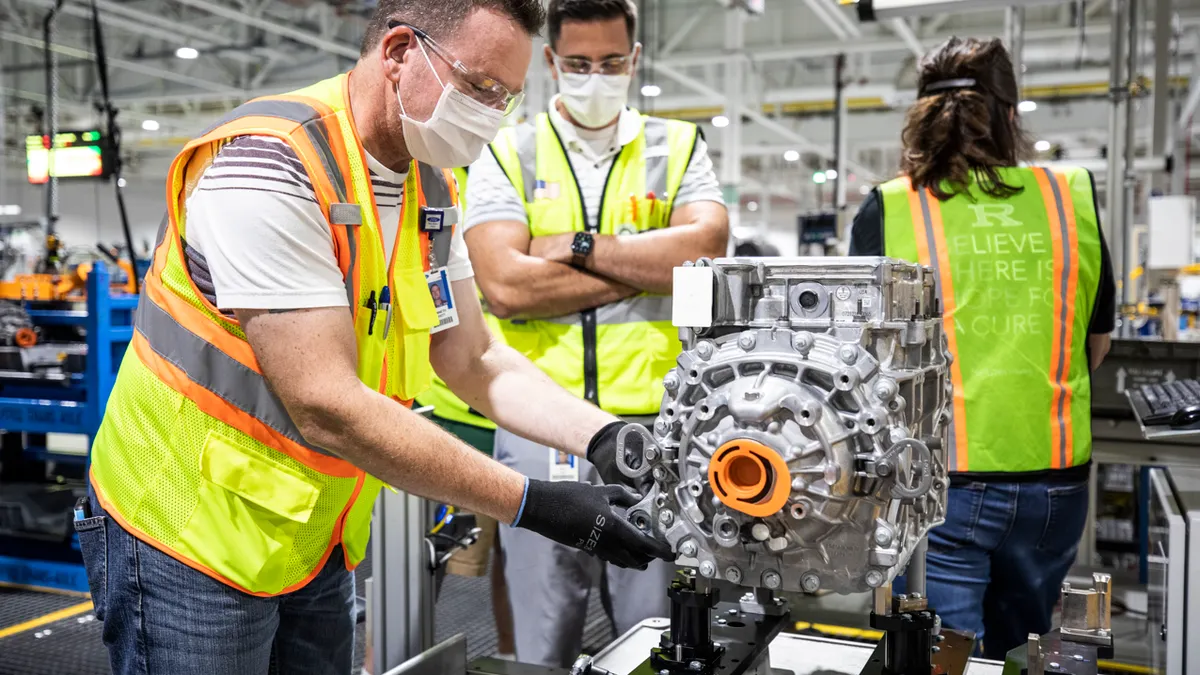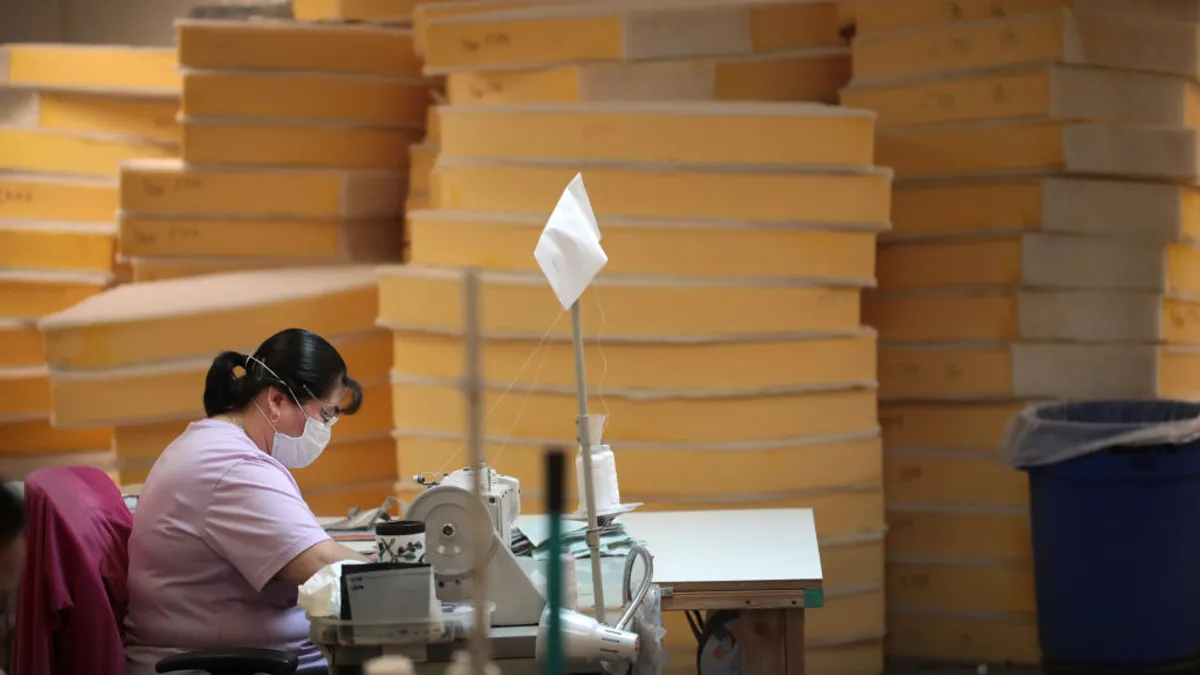Manufacturers have been working overtime for months to keep shelves stocked while ingredient suppliers race to keep supply chains from breaking. But as the pandemic rocks the food and beverage industry workforce, COVID-19 cases continue to grow and demand shifts from foodservice to retail, ingredients including mushrooms and carbon dioxide face potential shortages.
Bill Aimutis, executive director of the North Carolina Food Innovation Lab, told Food Dive that food manufacturers are using up their inventory in an effort to keep their pipelines available to retailers as the supply chain experiences disruptions. From the ingredients themselves to transportation issues, the coronavirus outbreak is causing shortages that could reoccur if the coronavirus continues to spread, he said.
Aimutis said the biggest concern will be if there is a secondary spike in the fall because that could disrupt transportation chains again, potentially making it more challenging to get those products imported into the U.S. from overseas.
Looking ahead, what lessons should companies learn from these current problems?
"One of them is to make sure that we have our supply chains mapped out very well for everything that we're doing in the processing world and know where we can move to if one piece of our supply chain is interrupted for some reason or another," Aimutis said. "A lot of companies don't take the time to do that, they have their first tier, maybe even a second tier of supplier, but they haven't thought about when this happens in China, where do we go from there? So that's been a little bit of an awakening for the industry."
Mushrooms
In May, the American Mushroom Institute said there would be shortages of the crop for the next six to 10 weeks. Mushroom farms saw a significant drop in orders in March amid the pandemic, which forced many to either donate or throw out coolers full of product.
Growers were also forced to limit workers onsite, as the coronavirus outbreak has hit agriculture across the U.S., leading to planting delays. Mushrooms, which grow in six- to 12-week cycles, need a period of preparing compost as well as time for two or three growth cycles.
"When the coronavirus hit, no one could have foreseen the markets’ unpredictability," Rachel Roberts, president of the American Mushroom Institute, said in a statement. "Mushroom growers made rapid decisions to sustain the health of their businesses and to protect the industry’s workforce in unprecedented and uncertain circumstances."
Although demand for mushrooms was down in restaurants, grocery store sales continue to rise. Retail mushroom sales jumped throughout April and increased 37% alone during the first week of May compared to last year, according to IRI data cited by UPI.
"Mushroom farms sometimes source from other growers to fill shortages; but because some were forced to reduce or delay the growing cycle, and because many farms with a majority of restaurant and foodservice customers had either shut down completely or scaled back to a negligible amount, it is still proving difficult to source mushrooms to fill shortages today," Roberts said in May.
"When the coronavirus hit, no one could have foreseen the markets’ unpredictability."

Rachel Roberts
President, American Mushroom Institute
Lori Harrison, a spokeswoman for the American Mushroom Institute, told Food Dive in an email that since then, and as more states move forward with their opening stages, mushrooms farms are increasing production, and they expect that as more restaurants come back online, both production and demand will increase.
"We're already seeing this a little bit as the reopening starts to occur," Aimutis said. Restaurants are "reconfiguring their menus, maybe to utilize less of the ingredients that they have difficulty getting."
Carbon dioxide
Beer, soda and seltzer water rely on carbon dioxide to give the beverages its fizzy mouth feel, so a depleting supply of CO2 from ethanol plants is causing concern among beverage makers.
Ethanol producers are a major supplier of the gas to food and beverage companies, but the market has been cut as consumers drive less, forcing many U.S. ethanol plants that sell carbon dioxide to idle or cut production.
Bob Pease, chief executive officer of the Brewers Association, told Reuters that carbon dioxide suppliers have increased prices by about 25% due to reduced supply.
"The problem is accelerating. Every day we're hearing from more of our members about this," Pease said.
It's not just beverage makers either, meat companies also depend on carbon dioxide to process, preserve and ship products. As a result, a coalition including the North American Meat Institute, Brewers Association and Beer Institute wrote in April a letter to Vice President Mike Pence where they expressed a "strong concern" that the ongoing coronavirus risks were creating a shortage of carbon dioxide.
"CO2 is critical for the operations of food and beverage manufacturers that provide essential goods and services to Americans. CO2 is used in the processing, packaging, preservation, and shipping of many foods," the letter said.
Garlic
The majority of garlic consumed in the U.S. is imported from China. Supply chains there were interrupted, which has weakened supply and increased prices. The cost of garlic are up 29% from last year during the pandemic, while wholesale prices are up 60% from the start of this year, according to the Wall Street Journal.
Globally, there is a struggle to produce enough garlic. Philippines Agriculture Secretary William Dar told U.S. senators in May that there is a shortage of both onions and garlic in the Philippines. He said the country is trying to boost its domestic production, but it takes time.
As COVID-19 impacts more countries, CEO of Olam Spices Greg Estep previously told Food Dive that orders in March for U.S.-grown onions, garlic and chilies jumped 20% from the previous year.
"The main shift from China to U.S. garlic is due to customers addressing supply chain concerns. However, we are seeing a large number of businesses who were sourcing garlic primarily from China, who are now looking to move some portion of their purchases to the U.S. as a contingency," he said in an email. "We believe that many customers will continue to stick with U.S. garlic in the longer term instead of relying on China as their single source."
With more trouble globally, more manufacturers may look to source their ingredients closer to home in the future.
Christopher Ranch in Gilroy, California told the Mercury News that its demand for garlic jumped 60%. The farm sells to grocery stores, restaurants and industrial buyers, but as quarantines started, the company went from selling 500,000 pounds of garlic a week to 800,000 pounds.
Yeast
Baking bread became a common past time for consumers over the last several months.
From sourdough to focaccia, pictures of homemade bread spread across social media during lockdowns. Those pictures inspired more and more shoppers to give bread making a try, causing demand for ingredients like flour and yeast to skyrocket past capacity.
Sales for baking yeast were up 258.5% compared to last year for the week ending May 23, according to Nielsen data emailed to Food Dive. As sales jumped, consumers started to complain about empty shelves and shortages of dry yeast.
Robb MacKie, CEO of the American Bakers Association, told Slate in April that the industry was not prepared for the run on yeast because there's usually a lull in demand for bread products and ingredients in the first quarter of the year, while the peak typically comes during the holiday season at the end of the year.
There is also a concern about workers getting sick when processing the product. Yeast plants have implemented more health measures for their employees. MacKie said facilities have been doing temperature checks, installing plexiglass shields and distributing PPE, similar to many other food processing facilities in the U.S.
"We need to keep these plants operational and protect the employees," MacKie said. "We are worried."






















